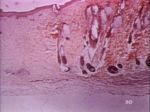Skin Repair
- Healing of a wound or surgical incision may be by:
- First intention
- Second intention.
Healing by First Intention
- Healing by first intention occurs when the incised ends remain in close apposition to each other and bacterial contamination is minimal.
- This may be induced by suturing.
- For example, a surgical incision.
- Results in minimal scarring.
Process
- Initially, the incision ruptures the dermal blood vessels.
- The exuded blood forms a fibrinous clot between and above the incision.
- The clot functions to:
- Stem the flow of blood from the injured site.
- Adhere the two ends together.
- Prevent infection from entering the injured area.
- The clot functions to:
- The exuded blood forms a fibrinous clot between and above the incision.
- The basal layer of epithelium wthin 1mm of the wound edge begins to lose its connections with adjacent basal and overlying epithelium.
- Undergoes mitosis.
- Begins to migrate down both sides of the wound under the clot using pseudopodia.
- As they are migrating, cells differentiate to some degree to form more superficial layers of the epithelium.
- Gives a rather thick, if not very strong, barrier of epidermis.
- In the area of migration, the skin is usually hypopigmented and lacks hair follicles.
- As they are migrating, cells differentiate to some degree to form more superficial layers of the epithelium.
- Within 2-4 days, the migrating basal layer of epithelium from either side meet together under the clot.
- It is thought that there is passage of substances, from one side to another that prevents further migration and mitosis.
- This gives reconstituion of an intact barrier to micro-organisms.
- While the epithelial changes are occuring, there is a sudden proliferation of local fibroblasts and accompanying endothelial cells in the dermis surrounding the incision.
- These grow across the narrow divide from each side and link up in the middle.
- Takes about 12 hours to accomplish.
- In the early stages (days 4-7), their alignment may be vertical, but in later stages (7-21 days) both fibroblasts and capillaries line up horizontally across the incision.
- This dermal repair forms the major portion of strength between the two sides at this time.
- Gains in strength over a long period of time as the collagen contracts and remodels according to the stresses imposed upon it.
- These grow across the narrow divide from each side and link up in the middle.
Factors Inhibiting Healing
- Factors inhibiting proper wound healing include:
- Protein deficiency
- May be absolute, as in starvation, or resolute, as in some of the endocrine deficiencies.
- E.g. hypothyroidism
- May be absolute, as in starvation, or resolute, as in some of the endocrine deficiencies.
- Vitamin C deficiency
- Vitamin C is essential for fibroplasia and to maintain the integrity of endothelial and epithelial cells.
- Cold
- Ageing
- Contamination
- Infection tends not to be a complication as bacteria are generally excluded.
- Retained foreign material such as hair portions or suture material inadvertently left in the wound will cause infection and/or a foreign body reaction.
- Infection tends not to be a complication as bacteria are generally excluded.
- Movement
- Gives persistent trauma.
- Protein deficiency
Healing by Second Intention
- Healing by second intention occurs when the gap between the ends of the incision is too wide to allow close approximation of the ends.
- This process of granulation tissue repair in a large wound is also the underlying process in the repair of:
- Infarcts and thrombi in vessels.
- Surface ulcers and diphtheresis.
- Pyogenic membrane in abscesses.
- Diffuse fibrosis ( cirrhosis ) in the liver.
Process
- In comparison to healing by first intention, there is a more massive fibroblastic and endothelial proliferation in the wound which fills and repairs the defect.
- There is also considerable surface exudation.
- The exudate is composed of fibrinous fluid and numerous inflammatory cells, mainly neutrophils and macrophages.
- The cells are scavengers, and engulf necrotic debris and any bacteria present
- Macrophages and their secretions are also important for the promotion of fibroplasia.
- The exudate is composed of fibrinous fluid and numerous inflammatory cells, mainly neutrophils and macrophages.
- The fibroblasts tend to align themselves roughly horizontal to the surface, but the endothelium is perpendicular to the surface.
- The upper vessels form loops near to the surface.
- Gives the gross appearance of red granules - this is granulation tissue.
- The upper vessels form loops near to the surface.
- Well-formed granulation tissue tends to be fairly resistant to surface infection; however, it is rather delicated and so susceptible to trauma and subsequent introduction of infection.
- Infection is therefore a common complication in the early stages of healing.
- Once the gap has been filled with granulation tissue and is free of infection, the epithelium migrates across.
- As it migrates, the epithelium secretes collagenolytic substances.
- The epidermis is usually hypopigmented and lacks hair follicles unless they have survived in the granulation tissue.
Factors Inhibiting Healing
- Several factors inhibit healing by second intention.
- Movement
- Movement before sufficient strength has been attained in the bond between the edges can inhibit healing.
- Infections
- Corticosteroids
- Prevent proper collagen matrix formation.
- Inhibit leukocyte emigration and phagocytosis.
- Diminish any acute inflammatory response by generally stabilising cellular membranes.
- Movement
Scarring
- As the fibroblasts mature into fibrocytes, the collagen also matures and contracts and there may be extensive scar formation.
- There may be considerable depression of the surface in such a scar.
- The scar may interfere with movement in the area.
- The scar tends to diminish in size over a long period of time, as the underlying collagen remodels according to the stresses imposed upon the area.
